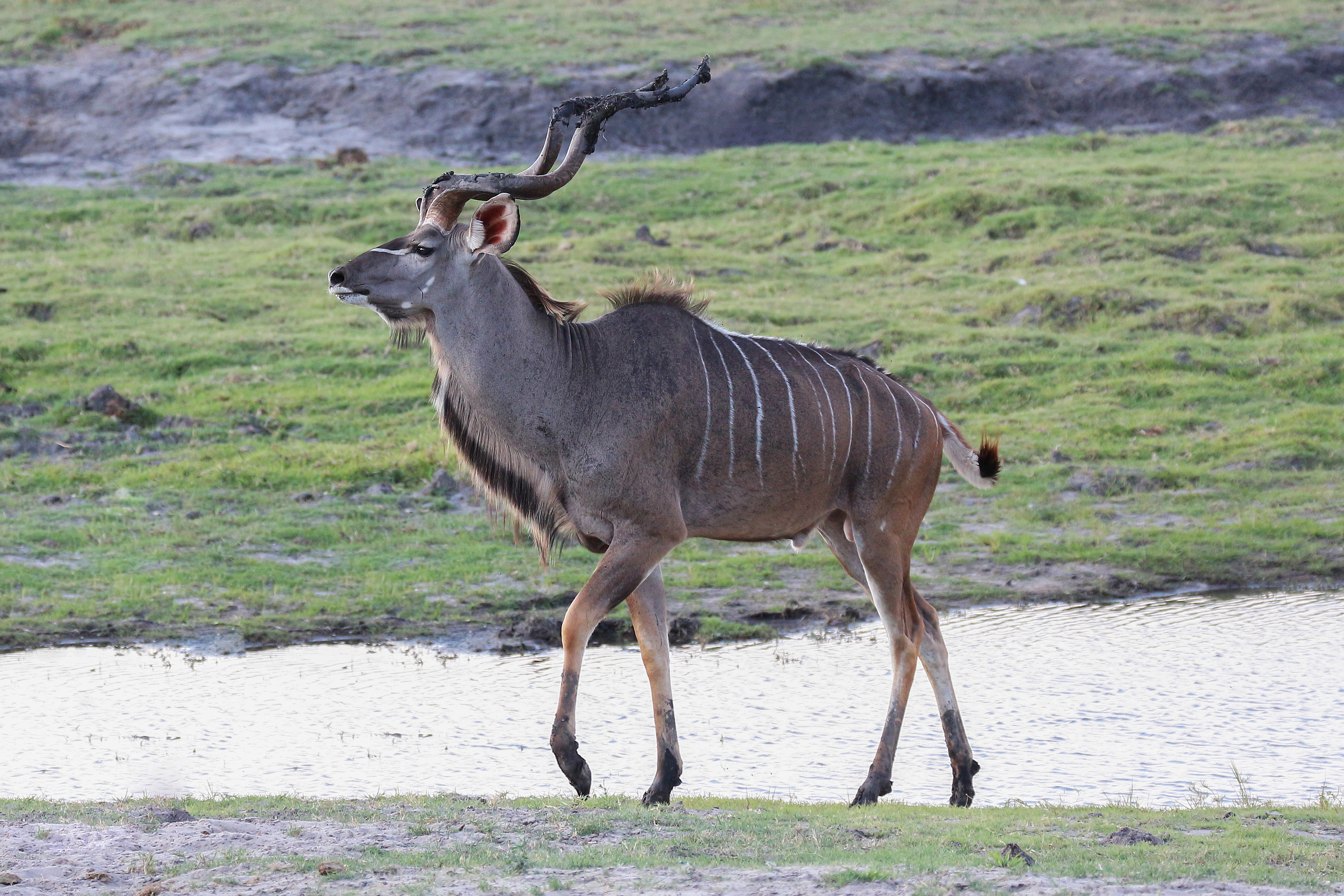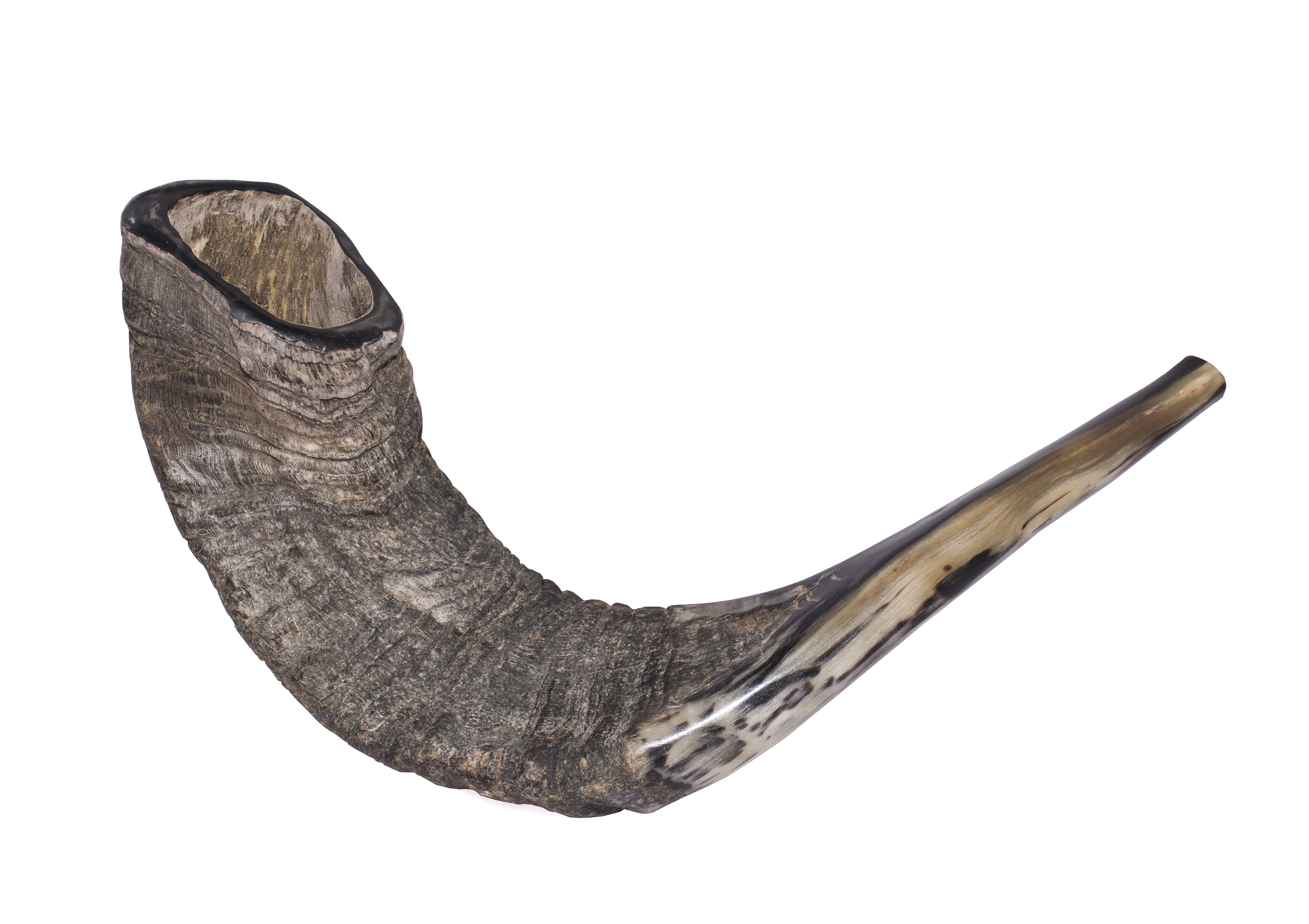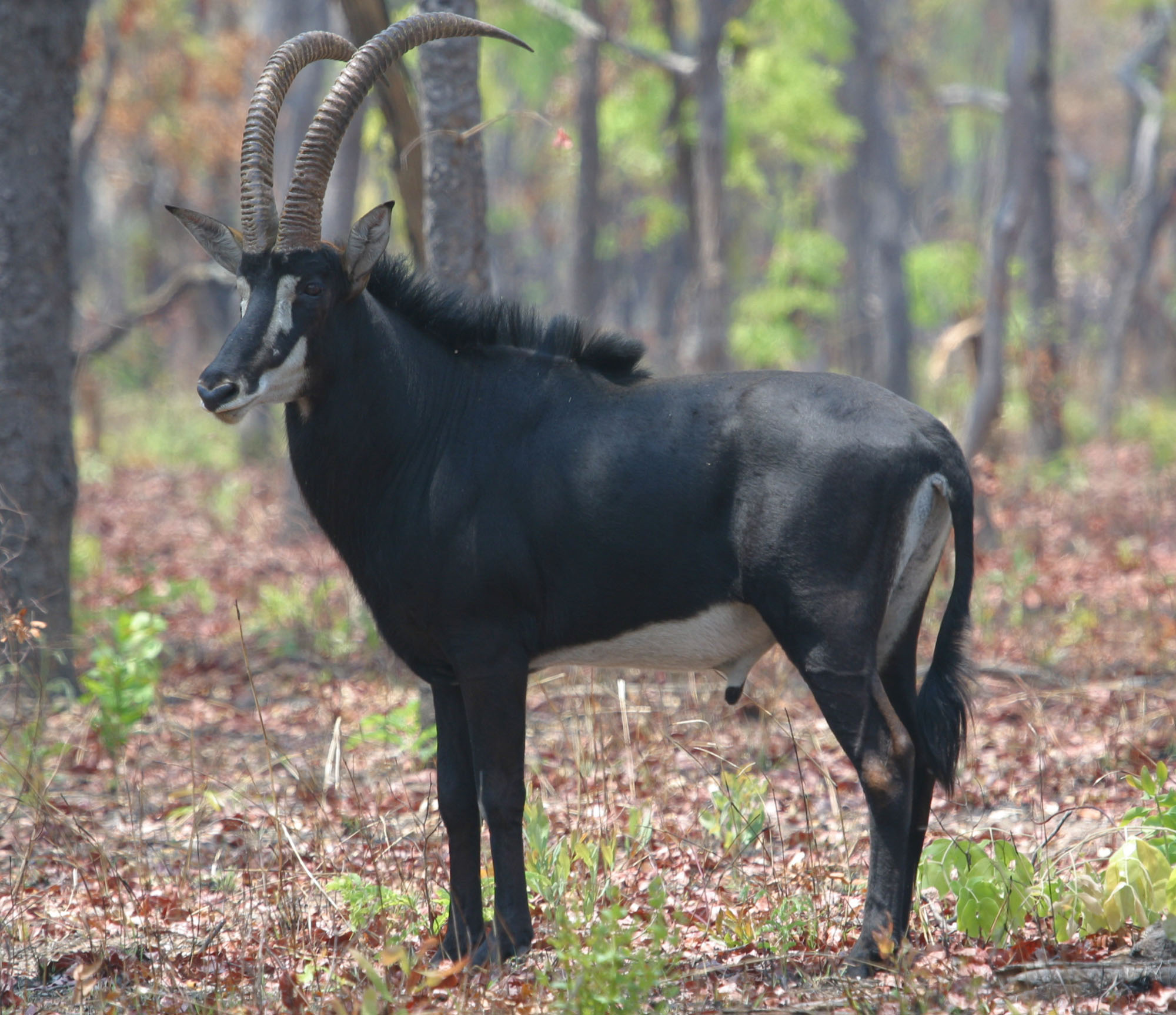|
Kudu
The kudus are two species of antelope of the genus '' Tragelaphus'': * Lesser kudu, ''Tragelaphus imberbis'', of eastern Africa * Greater kudu, ''Tragelaphus strepsiceros'', of eastern and southern Africa The two species look similar, though greaters are larger than lessers. A large adult male greater kudu stands over tall at the shoulder, and a large male lesser kudu stands about tall. Males of both species have long horns, which point upward and slightly back, curling in a corkscrew shape. Etymology The name of the animal was imported into English in the 18th century from isiXhosa ''iqhude'', via Afrikaans ''koedoe''. Kudu, or koodoo, is the Khoikhoi and seTswana name (Tholo is the Setswana name) for this antelope. ''Tragos'' (Greek) denotes a he-goat and ''elaphos'' (Greek) a deer. ''Strepho'' (Greek) means "I twist", and ''strephis'' is "twisting". ''Keras'' (Greek) means "horn". Habitat Lesser kudus occupy savanna near ''Acacia'' and '' Commiphora'' shrubs ... [...More Info...] [...Related Items...] OR: [Wikipedia] [Google] [Baidu] |
Greater Kudu
The greater kudu (''Tragelaphus strepsiceros'') is a large woodland antelope, found throughout East Africa, eastern and southern Africa. Despite occupying such widespread territory (animal), territory, they are sparsely populated in most areas due to declining habitat, deforestation, and poaching. The greater kudu is one of two species commonly known as kudu, the other being the lesser kudu, ''T. imberbis''. Etymology Kudu ( ), or koodoo, is the Khoikhoi name for this antelope. ''Trag-'' (Greek) denotes a goat and ''elaphos'' (Greek) a deer. ''Strepho'' (Greek) means 'twist', and ''strepsis'' is 'twisting'. ''Keras'' (Greek) refers to the horn of the animal. Physical characteristics Greater kudus have a narrow Anatomy, body with long legs, and their coat (animal), coats can range from brown/bluish grey to reddish brown. They possess between 4 and 12 vertical white stripes along their torso. The head tends to be darker in colour than the rest of the body, and exhibits a small ... [...More Info...] [...Related Items...] OR: [Wikipedia] [Google] [Baidu] |
Lesser Kudu
The lesser kudu (''Tragelaphus imberbis'') is a medium-sized bushland antelope found in East Africa. The species is a part of the ungulate genus '' Tragelaphus'' (family Bovidae), along with several other related species of striped, spiral-horned African bovids, including the related greater kudu, the bongo, bushbuck, common and giant elands, nyala and sitatunga. It was first scientifically described by English zoologist Edward Blyth (1869). The lesser kudu’s nose-to-tail length is typically . Males reach about at the shoulder, while females reach . Males typically weigh and females . Horns are present only on males. The spiral horns are long, and have 2-2.5 complete twists. The lesser kudus have very distinctive physical markings; females and juveniles have a golden-brown coat, with white vertical stripes on their sides, while the males develop into a dark grey colour—after about two years—and grow a pronounced “streak” of shaggy hair down the centre of their ... [...More Info...] [...Related Items...] OR: [Wikipedia] [Google] [Baidu] |
Kudu (17418137574)
The kudus are two species of antelope of the genus '' Tragelaphus'': * Lesser kudu, ''Tragelaphus imberbis'', of eastern Africa * Greater kudu, ''Tragelaphus strepsiceros'', of eastern and southern Africa The two species look similar, though greaters are larger than lessers. A large adult male greater kudu stands over tall at the shoulder, and a large male lesser kudu stands about tall. Males of both species have long horns, which point upward and slightly back, curling in a corkscrew shape. Etymology The name of the animal was imported into English in the 18th century from isiXhosa ''iqhude'', via Afrikaans ''koedoe''. Kudu, or koodoo, is the Khoikhoi and seTswana name (Tholo is the Setswana name) for this antelope. ''Tragos'' (Greek) denotes a he-goat and ''elaphos'' (Greek) a deer. ''Strepho'' (Greek) means "I twist", and ''strephis'' is "twisting". ''Keras'' (Greek) means "horn". Habitat Lesser kudus occupy savanna near ''Acacia'' and ''Commiphora'' shrubs. The ... [...More Info...] [...Related Items...] OR: [Wikipedia] [Google] [Baidu] |
Tragelaphus
''Tragelaphus'' is a genus of medium-to-large-sized spiral-horned antelopes. It contains several species of bovines, all of which are relatively antelope-like. Species in this genus tend to be large in size and lightly built, and have long necks and considerable sexual dimorphism. Elands, including the common eland (''Taurotragus oryx''), are embedded within this genus, meaning that ''Taurotragus'' must be subsumed into ''Tragelaphus'' to avoid paraphyly. Alternatively, ''Taurotragus'' could be maintained as a separate genus, if the nyala and the lesser kudu are relocated to their own monospecific genera, respectively ''Nyala'' and ''Ammelaphus''. ''Strepsiceros'' is a generic synonym. Genus ''Boocercus'' formerly contained ''T. eurycerus''. The name "Tragelaphus" comes from the mythical tragelaph. Taxonomy and phylogeny ''Tragelaphus'' is a genus in the tribe Tragelaphini and the family Bovidae. The genus authority is French zoologist Henri Marie Ducrotay de Blainville, w ... [...More Info...] [...Related Items...] OR: [Wikipedia] [Google] [Baidu] |
Shofar
A shofar ( ; from , ) is an ancient musical horn, typically a ram's horn, used for Jewish ritual purposes. Like the modern bugle, the shofar lacks pitch-altering devices, with all pitch control done by varying the player's embouchure. The shofar is blown in synagogue services on Rosh Hashanah and at the end of Yom Kippur; it is also blown every weekday morning in the month of Elul running up to Rosh Hashanah. Shofars come in a variety of sizes and shapes, depending on the choice of animal and level of finish. Bible and rabbinic literature The shofar is mentioned frequently in the Hebrew Bible, the Talmud and rabbinic literature. In the first instance, in , the blast of a shofar emanating from the thick cloud on Mount Sinai makes the Israelites tremble in awe. The shofar was used to announce the new moon and the Jubilee year. The first day of Tishrei (now known as Rosh Hashana) is termed a "memorial of blowing", or "day of blowing", the shofar. Shofars were used for si ... [...More Info...] [...Related Items...] OR: [Wikipedia] [Google] [Baidu] |
Antelope
The term antelope refers to numerous extant or recently extinct species of the ruminant artiodactyl family Bovidae that are indigenous to most of Africa, India, the Middle East, Central Asia, and a small area of Eastern Europe. Antelopes do not form a monophyletic group, as some antelopes are more closely related to other bovid groups, such as bovines, goats, and sheep, than to other antelopes. A stricter grouping, known as the true antelopes, includes only the genera '' Gazella'', '' Nanger'', '' Eudorcas'', and '' Antilope''. One North American mammal, the pronghorn or "pronghorn antelope", is colloquially referred to as the "American antelope", despite the fact that it belongs to a completely different family ( Antilocapridae) than the true Old-World antelopes; pronghorn are the sole extant member of an extinct prehistoric lineage that once included many unique species. Although antelope are sometimes referred to, and easily misidentified as, "deer" ( cervids), true ... [...More Info...] [...Related Items...] OR: [Wikipedia] [Google] [Baidu] |
Wood Badge
Wood Badge is a Scout leader training program, first implemented by The Scout Association, The Boy Scouts Association in the United Kingdom in 1919 and subsequently adopted, with variations, by some other Scout organizations. Wood Badge Course (education), courses teach Scout leadership skills and instil an ideological Human bonding, bond and Personal commitment, commitment to the organizations. Courses generally have theory and practical phases followed by a practice project. Scouters who complete the course are awarded a pair of wood beads on each end of a leather thong, from a necklace of beads Robert Baden-Powell claimed to have taken from the African chief Dinizulu. Insignia The Wood Badge is worn around the neck as part of the Scouter's uniform. In some Scout organizations, the wood badge is presented together with a #Gilwell_scarf_or_neckerchief, Gilwell scarf and a #Gilwell_woggle, Gilwell woggle, denoting membership of the notional #1st_Gilwell_Scout_Group, 1st Gilw ... [...More Info...] [...Related Items...] OR: [Wikipedia] [Google] [Baidu] |
Scouting
Scouting or the Scout Movement is a youth social movement, movement which became popularly established in the first decade of the twentieth century. It follows the Scout method of informal education with an emphasis on practical outdoor activities, including camping, woodcraft, aquatics, hiking, Backpacking (wilderness), backpacking and sports. A widely recognized movement characteristic is the Scout uniform, by intent Social hierarchies, hiding all differences of social standing and encouraging Social equality, equality, with neckerchief (known as a scarf in some countries) and (originally) a campaign hat or comparable Headgear, headwear. Distinctive insignia include the World Scout Emblem, fleur-de-lis as well as Scout badge, merit badges or patches. In some countries, Girl Guides organizations, using a trefoil insignia, exist for girls to carry-out scout training. Other programs for children who are too young to be Scouts and take the Scout Promise, such as Wolf Cubs or Cub ... [...More Info...] [...Related Items...] OR: [Wikipedia] [Google] [Baidu] |
Spotted Hyena
The spotted hyena (''Crocuta crocuta''), also known as the laughing hyena, is a hyena species, currently classed as the sole extant member of the genus ''Crocuta'', native to sub-Saharan Africa. It is listed as being of least concern by the IUCN due to its widespread range and large numbers estimated between 27,000 and 47,000 individuals. The species is, however, experiencing declines outside of protected areas due to habitat loss and poaching. Populations of ''Crocuta'', usually considered a subspecies of ''Crocuta crocuta'', known as cave hyenas, roamed across Eurasia for at least one million years until the end of the Late Pleistocene. The spotted hyena is the largest extant member of the Hyaenidae, and is further physically distinguished from other species by its vaguely bear-like build, rounded ears, less prominent mane, spotted pelt, more dual-purposed dentition, fewer nipples, and #Female genitalia, pseudo-penis. It is the only placental mammalian species where females hav ... [...More Info...] [...Related Items...] OR: [Wikipedia] [Google] [Baidu] |
African Wild Dog
The African wild dog (''Lycaon pictus''), also called painted dog and Cape hunting dog, is a wild canine native to sub-Saharan Africa. It is the largest wild canine in Africa, and the only extant member of the genus '' Lycaon'', which is distinguished from ''Canis'' by dentition highly specialised for a hypercarnivorous diet and by a lack of dewclaws. It is estimated that there are around 6,600 adults (including 1,400 mature individuals) living in 39 subpopulations, all threatened by habitat fragmentation, human persecution and outbreaks of disease. As the largest subpopulation probably consists of fewer than 250 individuals, the African wild dog has been listed as endangered on the IUCN Red List since 1990. The African wild dog is a specialized hunter of terrestrial ungulates, mostly hunting at dawn and dusk, but also displays diurnal activity. It captures its prey by using stamina and cooperative hunting to exhaust them. Its natural competitors are lions and spotted hyenas ... [...More Info...] [...Related Items...] OR: [Wikipedia] [Google] [Baidu] |
Panthera Leo Melanochaita
''Panthera leo melanochaita'' is a lion subspecies in Southern Africa, Southern and East Africa. In this part of Africa, lion populations are regionally locally extinct, extinct in Lesotho, Djibouti and Eritrea, and are threatened by loss of habitat and prey base, killing by local people in retaliation for loss of livestock, and in several countries also by trophy hunting. Since the turn of the 21st century, lion populations in intensively managed protected areas in Botswana, Namibia, South Africa and Zimbabwe have increased, but declined in East African range countries. In 2005, a Lion Conservation Strategy was developed for East and Southern Africa. Results of a phylogeographic study indicate that lion populations in southern and eastern Africa form a major clade distinct from lion populations in West Africa, Central Africa and Asia. In 2017, the Cat Classification Task Force of the IUCN Cat Specialist Group subsumed lion populations according to the major clades into two subspe ... [...More Info...] [...Related Items...] OR: [Wikipedia] [Google] [Baidu] |
Horn (instrument)
A horn is any of a family of musical instruments made of a tube, usually made of metal and often curved in various ways, with one narrow end into which the musician blows, and a wide end from which sound emerges. In horns, unlike some other brass instruments such as the trumpet, the bore gradually increases in width through most of its length—that is to say, it is conical rather than cylindrical. In jazz and popular-music contexts, the word may be used loosely to refer to any wind instrument, and a section of brass or woodwind instruments, or a mixture of the two, is called a horn section in these contexts. Types Variations include: * Lur (prehistoric) * Shofar * Alboka *Roman horns: ** Cornu ** Buccina * Dung chen * Dord * Sringa * Nyele * Wazza * Waqra phuku * Alphorn *Cornett * Serpent * Ophicleide * Natural horn ** Bugle ** Post horn *French horn * German horn * Vienna horn * Wagner tuba * Saxhorns, including: ** Alto horn (UK: tenor horn), pitched in E ** Baritone ho ... [...More Info...] [...Related Items...] OR: [Wikipedia] [Google] [Baidu] |









